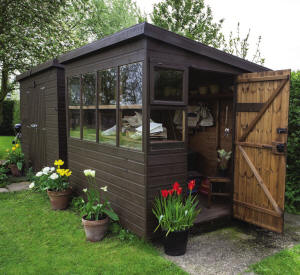|
 Fall Home Improvement
Magazine Special Feature Fall Home Improvement
Magazine Special Feature
Now that you have it, where do you store it?
By Nila Smith
 Send a link to a friend
Send a link to a friend
[October 06, 2015]
Whether you are a homeowner or a tenant, storage
can become an issue that is difficult to address, especially when it
is time to clean up the yard, put away all those gardening tools,
take down summer décor, find a place for the garden hose and the
flower baskets, and store away the kids outdoor toys.
|
|
 For some, the easiest solution could be a corner of the basement
or a spot in the garage, but if you don’t have a basement or garage,
what do you do? For some, the easiest solution could be a corner of the basement
or a spot in the garage, but if you don’t have a basement or garage,
what do you do?
There are several options, depending on what kind of space you do
have available in your backyard, and of course, how much you have to
store.
If you are a renter, don’t rule out a storage building. These
buildings can be purchased ready made on skids that make them
moveable. The term skid simply means that there are cross bars under
the floor that made it possible for the building to be moved without
a great deal of labor involved. If you have a large back yard and a
cooperative landlord, this could be your answer.
These buildings are available in a variety of sizes and styles so
you have the option to pick and choose exactly what will fit your
needs. Fitting them into the budget may be another issue, but before
you rule them out completely, do some shopping.


If having a storage building of your own is not going to work out,
another option could be a rental space at a storage facility. Spaces
are available in a variety of sizes from something large enough to
hold a house full of furniture to something as small as a walk-in
closet. If this is something you think could work for you, there
are a few considerations before you sign the contract.
Some may think at first that renting a storage unit could be a
budget buster, but according to Roger Bruns in Lincoln, the
self-storage units he has can be quite affordable depending on the
size needed. The units at Brun’s are available in five sizes ranging
from a six by 10 foot unit, all the way up to a 10 by 24 foot unit.
Prices range from $30 a month to $85 a month.
Consider if you have a nice patio set - a glass top table, four nice
chairs, maybe an umbrella, a good gas grill, an inflatable pool, and
a couple of bicycles. Add up what it would cost to replace all those
items if they were damaged by weather, and you may find that a
monthly payment even as high as $85 for the very largest unit is
affordable in the long-run.
Note: Bruns' did state that he tries very hard to avoid having
flammable items placed in his units, so take the LP tank off of the
grill before you store it.
He said there is a contract to sign, but units are rented on a
month-to-month basis, and the rent is paid monthly, so you have the
option to take a unit and keep it only as long as you need it and
empty it out at any time.
[to top of second column] |

One hazard to consider with self-storage is, there is no insurance on your items
through the self-storage business. But, check with your insurance provider. You
may be able to have coverage for your stored items through your homeowner’s
policy.
If a storage unit or a portable shed is not an option for you at this time,
there are other, less sophisticated ways to protect your outdoor items during
the winter. Tarpaulins’ are available at local farm supply stores such as Big R
in Lincoln. Stack your items together and cover them with the ‘tarp’, and then
weight it down with bricks or blocks. Get a long piece of cord or rope and tie
the tarp around the stack about half way down to help keep the wind from getting
into it. Another option is rolled plastic. This can be purchased in a variety of
thicknesses and sizes at locations such as Wal-Mart, and can be used in the same
manner as the tarp.
And finally, check out what is offered at the local hardware and building supply
stores. Today there are a lot of options for portable storage such as heavy duty
trunks or tall cabinets made of heavy plastic. Units like these can be used
outdoors, or if you do have a garage, inside also.
Regardless of how you protect your items through the winter months, remember
that you are doing so to protect your investments. While storage options can add
up to more dollars spent, which could impact a tight budget, you’ve worked hard
to get what you have, and investing in protecting it will mean that you are able
to extend the life of your assets.

|